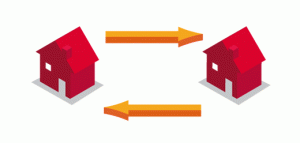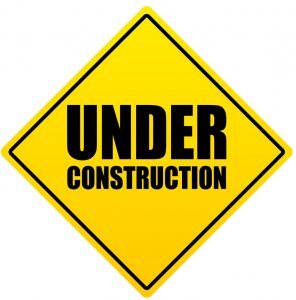Investment Properties –
The 1031 Tax Deferred Exchange is a strategy used by real estate investors to defer capital gains taxes, and is allowed under IRS tax code 1031.
By using a 1031 exchange, an investor can defer paying capital gains taxes on an investment property when it is sold, as long as another “like-kind” property is purchased with the profit gained by the sale of the first property.
Traditionally, a 1031 exchange is where one property is literally
one property is literally
swapped for another property of like-kind. But finding someone that literally want’s your property and you want their property are pretty slim, so the delayed exchange is more common.
In a delayed exchange, you will need a middle-man who holds the cash for you after you sell your property. They will use that money to buy the replacement property for you. This 3 party exchange is treated as a swap.
When you sell an investment property, even if you weren’t the one who initially purchased, you end up on the hook to pay capital gains tax.
If you’ve made some not so great investments, selling your investment can cost you more than you make. But, if you own a rental property that’s worth significantly more today than what you bought it for, you may be able to come out ahead using this powerful strategy. It’s an important tool for real estate investors, and has become a bulls-eye for tax reform evangelists.
However, the exchange rules require that both the purchase price and the new loan amount be the same or higher on the replacement property.
Example: An investor is selling a $500,000 single family home she’s using as an income property in the LA Area with a $400,000 loan. She wants to buy a multi-family home for income here in the Desert; the replacement property must be valued at $500,000 or more with $400,000 or more leverage, (loan amount).
4 types of Real Estate Exchanges:
 1) Simultaneous Exchange – occurs when the replacement property and relinquished property close on the same day. It is important to note that the exchange must occur simultaneously; any delay, even a short delay caused by wiring money to an escrow company, can result in the disqualification of the exchange and the immediate application of full taxes.
1) Simultaneous Exchange – occurs when the replacement property and relinquished property close on the same day. It is important to note that the exchange must occur simultaneously; any delay, even a short delay caused by wiring money to an escrow company, can result in the disqualification of the exchange and the immediate application of full taxes.
Three basic ways a Simultaneous Exchange can occur.
- Swap or complete a two-party trade, whereby the two parties exchange or “swap” deeds.
- Three-party exchange where an “accommodating party” is used to facilitate the transaction in a simultaneous fashion for the exchanger.
- Simultaneous exchange with a qualified intermediary who structures the entire exchange.
2)Delayed Exchange – The most common type of exchange chosen by investors; occurs when the Exchangor relinquishes the original property before acquiring the replacement property. In this scenario, the investor has 45 days to identify the replacement property and 180 days to complete the sale of their new property.
Using this strategy, an investor has a maximum of 45 days to identify the replacement property and 180 days to complete the sale of their property. In addition to the numerous tax benefits, this extended time frame is one of the reasons the delayed exchange is so popular.
3) Reverse Exchange – Also known as a Forward Exchange, occurs when you acquire a replacement property through an exchange accommodation titleholder before you identify the replacement property. Essentially, you buy first and pay later. This type of exchange can be tricky because it requires all cash. Many banks won’t offer loans on reverse exchanges. Taxpayers must also decide which of their investment properties are going to be acquired and which will be “parked.” A failure to close on the relinquished property during the established 180 day period that the acquired property is parked will result in a forfeit of the exchange.
The rules for a Reverse Exchange are similar with a couple of key differences.
- Tax payers have 45 days to ID what property is going to be sold as “The relinquished property”
- After the initial 45 days, taxpayers have 135 day to complete the sale of the identified property and close out the reverse 1031 exchange with the purchase of the replacement property.

4) Construction or Improvement Exchange
The taxpayer can use their tax-deferred dollars to enhance the replacement property while it is placed in the hands of a qualified intermediary for the remainder of the 180 day period.
It’s important to note that the taxpayer must also meet three requirements if they want to defer all of the gain (from the sale of the relinquished property) and instead use it as part of the construction or improvement exchange.
3 key requirements for a Construction or Improvement Exchange
- The entire exchange equity must be spent on completed improvements or as down payment by the 180th day.
- The taxpayer must receive “substantially the same property” that they identified by the 45th day.
- The replacement property must be equal or greater in value when it is deeded back to the taxpayer. The improvements must be in place before the taxpayer can take the title back from the qualified intermediary.
7 Primary 1031 Exchange Rules.
- Like-kind Property
- Investment or Business purposes only
- Greater of equal value
- Must not receive “Boot”
- Same Tax Payer
- 45 Day Identification window
- 180 Day Purchase Window
Check out this FAB Home in South Palm Desert for Great Rental Income
 We hope your main take-away is; you too can end up with passive income from real estate. But, it’s not easy for even the most seasoned real estate investor. Having the right team working for you will be important to set the stage properly. We have a team of professionals that can help. For more info, give us a call today – we’re happy to help.
We hope your main take-away is; you too can end up with passive income from real estate. But, it’s not easy for even the most seasoned real estate investor. Having the right team working for you will be important to set the stage properly. We have a team of professionals that can help. For more info, give us a call today – we’re happy to help.
